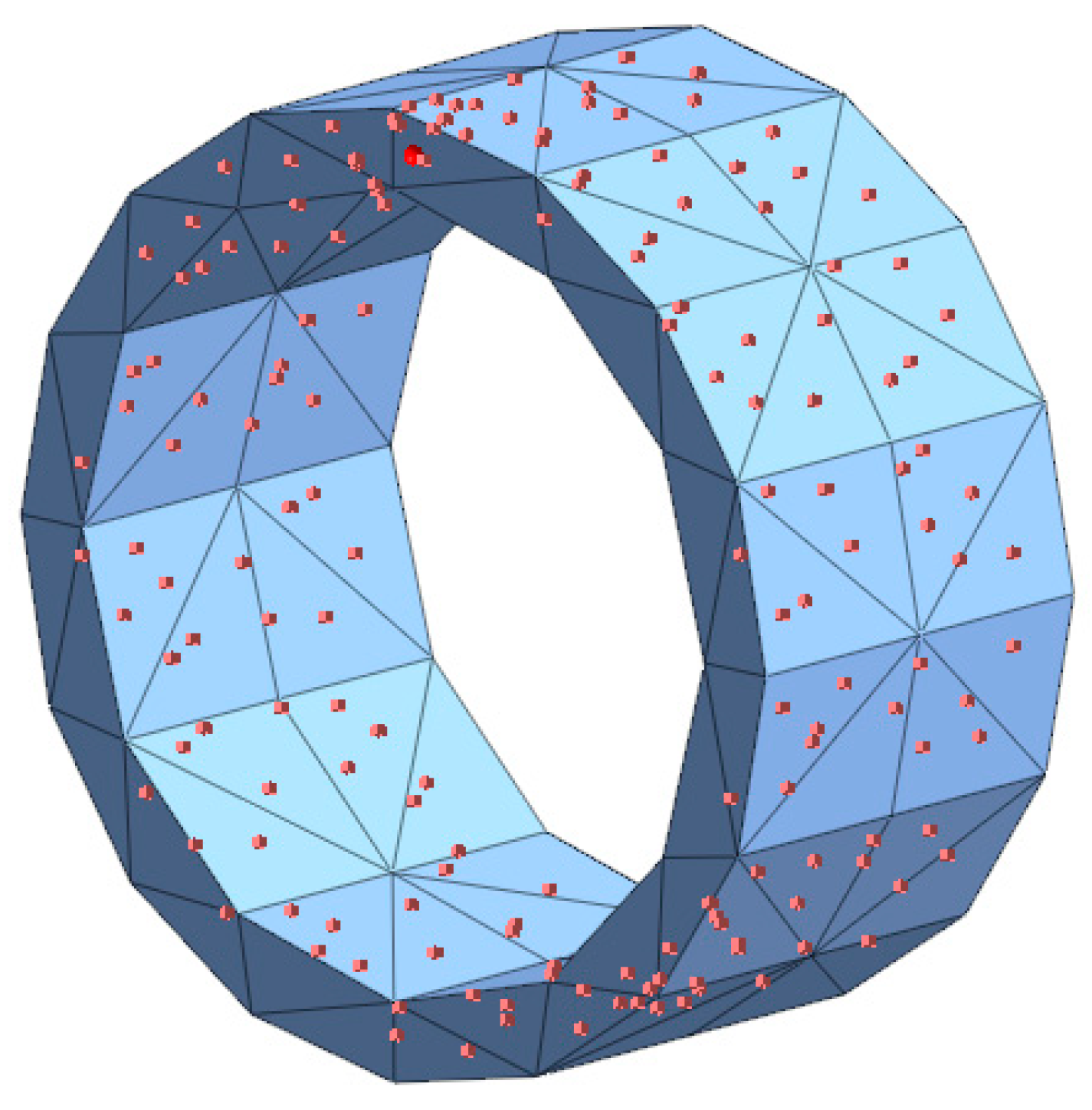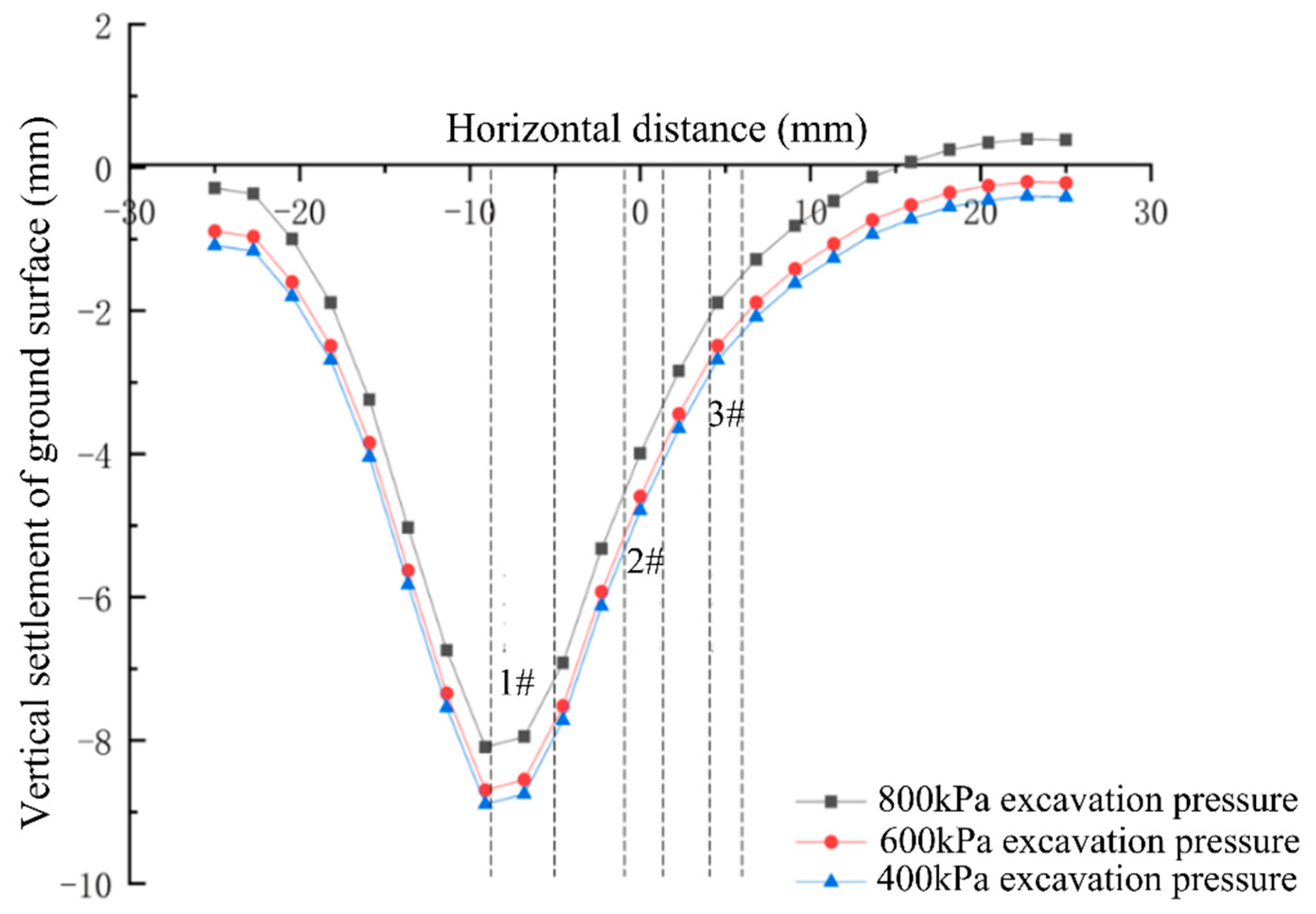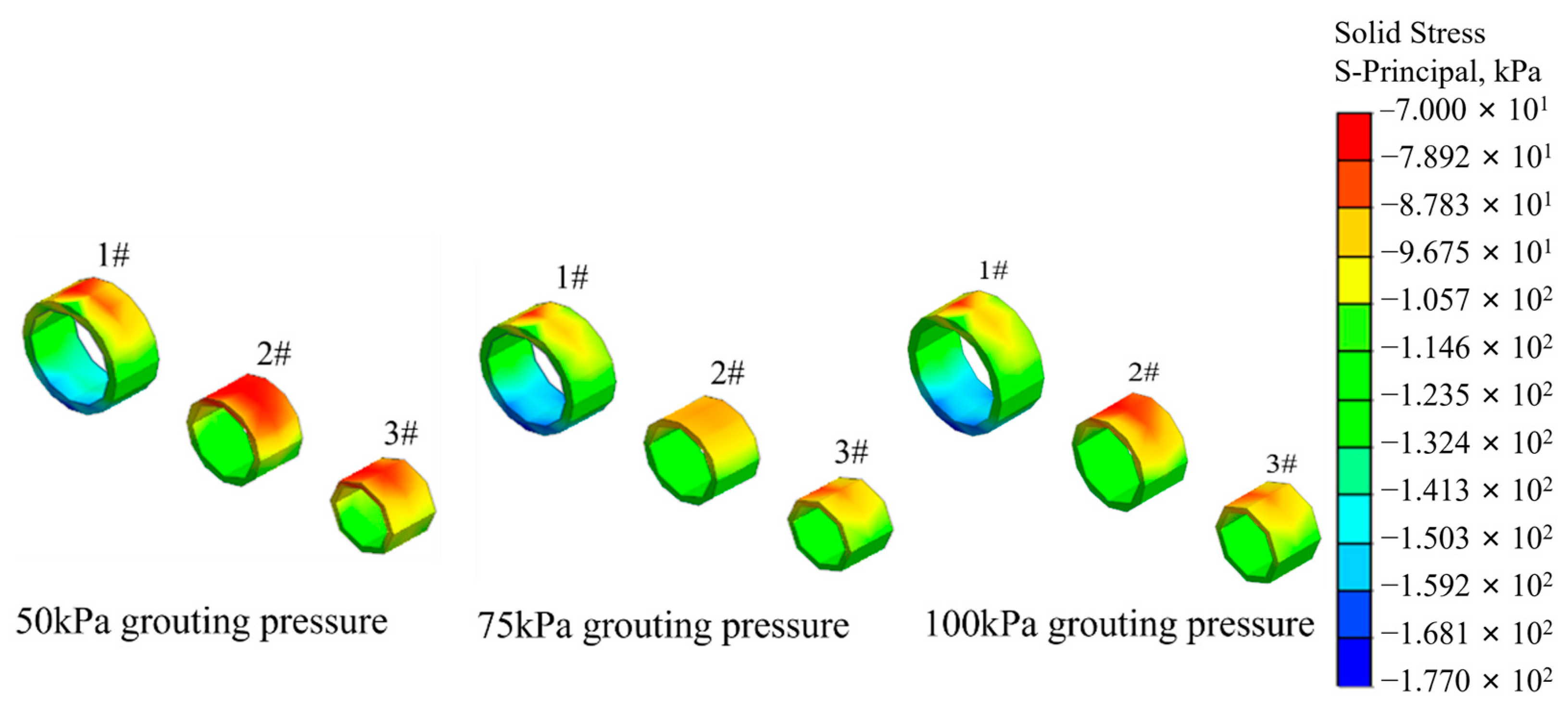Behavioral Investigations of Three Parallel Large Reinforced Concrete Circular Pipes with the Construction of Pipe Jacking
Abstract
1. Introduction
2. Engineering Profile
3. Numerical Model for the Simulation of Jacking Reinforced Concrete Circular Pipes
3.1. Geometric Model Establishment and Material Properties
3.2. Imposed Forces during Pipe Jacking
3.2.1. Excavation Pressure on Tunnel Excavation Face and Pushing Pressure on the Segments
3.2.2. Grouting Pressures and Frictional Resistance Forces
4. Numerical Behavior of Jacking Reinforced Concrete Circular Pipes
4.1. Behavior Influenced by Excavation Pressure
4.1.1. Stress Distribution of the Jacked Reinforced Concrete Circular Pipes
4.1.2. Deformation of the Jacked Reinforced Concrete Circular Pipes
4.1.3. Vertical Settlements of Ground Surface
4.2. Behavior Influenced by Grouting Pressure from Drag-Reducing Thixotropic Slurry
4.2.1. Stress Distribution of the Jacked Reinforced Concrete Circular Pipes
4.2.2. Deformation of the Jacked Reinforced Concrete Circular Pipes
4.2.3. Vertical Settlements of Ground Surface
5. Conclusions
- (1)
- Increasing excavation pressure from the pipe jacking machine has little impact on the stress and overall deformation of the reinforced concrete circular pipe, whereas higher excavation pressure from the pipe jacking machine can easily induce an excessive pushing and squeezing effect of the excavated soil with uplift phenomenon, in which the soil mass is continuously pushed outward and far away from the pipe jacking machine.
- (2)
- Increasing grouting pressure can reduce the stresses of the reinforced concrete circular pipe, whereas the stress variation of the reinforced concrete circular pipe is not significantly related to the increasing grouting pressure to a certain extent, which means excessive grouting pressure may have no effect on protecting the reinforced concrete circular pipes, and an appropriate grouting pressure should be adopted during the pipe jacking process.
- (3)
- Firstly, jacking the 1# and 3# reinforced concrete circular pipes has an obvious influence on the ultimate vertical settlement of the ground surface and the stress distribution of the 2# reinforced concrete circular pipe, and the subsequent process of jacking the 2# reinforced concrete circular pipe has a relatively small impact on the ultimate vertical settlement of the ground surface and stress distribution of the jacked 1# and 3# pipes.
- (4)
- The main grouting-pressure-induced deformations occurred at the upper and lower parts of all the reinforced concrete circular pipes, and gradually increased with increasing grouting pressure, whereas they changed little after the grouting pressure had increased to a certain extent. Moreover, increasing grouting pressure can be used to reduce the overall vertical settlement of the ground surface due to continuously decreased vertical settlement of the ground surface with gradually increased grouting pressure.
Author Contributions
Funding
Institutional Review Board Statement
Informed Consent Statement
Data Availability Statement
Conflicts of Interest
References
- Sheil, B.B.; Suryasentana, S.K.; Templeman, J.O.; Phillips, B.M.; Cheng, W.C.; Zhang, L.M. Prediction of pipe-jacking forces using a bayesian updating approach. J. Geotech. Geoenviron. 2022, 148, 04021173. [Google Scholar] [CrossRef]
- Tao, L.J.; Zhang, Y.; Zhao, X.; Bian, J.; Chen, X.H.; An, S.; Han, X.C. Group effect of pipe jacking in silty sand. J. Geotech. Geoenviron. 2021, 147, 05021012. [Google Scholar] [CrossRef]
- Zhang, P.; Feng, X.; Zeng, C.; Ariaratnam, S.T. Field performance of steel pipes during curve jacking in Gongbei tunnel. Tunn. Undergr. Space Technol. 2022, 128, 104585. [Google Scholar] [CrossRef]
- Ma, W.J.; Wang, B.L.; Wang, X.; Zhou, S.H.; Wang, B.L. Soil layer disturbance caused by pipe jacking: Measurement and simulation of a case study. KSCE J. Civ. Eng. 2021, 25, 1467–1478. [Google Scholar] [CrossRef]
- Sagaseta, C. Analysis of undrained soil deformation due to ground loss. Geotechnique 1987, 37, 301–320. [Google Scholar] [CrossRef]
- Ren, D.J.; Xu, Y.S.; Shen, J.S.; Arulrajaj, A. Prediction of ground deformation during pipe-jacking considering multiple factors. Appl. Sci. 2018, 8, 1051. [Google Scholar] [CrossRef]
- Rowe, R.K.; Kack, G.J.A. theoretical examination of the settlements induced by tunneling: Four case histories. Can. Geotech. J. 1983, 20, 299–314. [Google Scholar] [CrossRef]
- Wen, K.; Zeng, W.; Shimada, H.; Sasaoka, T.; Hamanaka, A. Numerical and theoretical study on the jacking force prediction of slurry pipe jacking traversing frozen ground. Tunn. Undergr. Space Technol. 2021, 115, 104076. [Google Scholar] [CrossRef]
- Wen, K.; Shimada, H.; Zeng, W.; Sasaoka, T.; Qian, D.Y. Frictional analysis of pipe-slurry-soil interaction and jacking force prediction of rectangular pipe jacking. Eur. J. Environ. Civ. Eng. 2020, 24, 814–832. [Google Scholar] [CrossRef]
- Li, C.; Zhong, Z.L.; Liu, X.R.; He, G.N. Numerical simulation for an estimation of the jacking force of ultra-long-distance pipe jacking with frictional property testing at the rock mass-pipe interface. Tunn. Undergr. Space Technol. 2019, 89, 205–221. [Google Scholar] [CrossRef]
- Ye, Y.C.; Peng, L.M.; Zhou, Y. Prediction of friction resistance for slurry pipe jacking. Appl. Sci. 2020, 10, 207–227. [Google Scholar] [CrossRef]
- Shen, S.L.; Cui, Q.L.; Ho, C.E.; Xu, Y.S. Ground response to multiple parallel microtunneling operations in cemented silty clay and sand. J. Geotech. Geoenviron. 2016, 142, 04016001. [Google Scholar] [CrossRef]
- Jiang, X.; Zhang, X.H.; Wang, S.; Bai, Y.; Huang, B.S. Case study of the largest concrete earth pressure balance pipe-jacking project in the world. Transport. Res. Rec. 2022, 2676, 92–105. [Google Scholar] [CrossRef]
- Zeng, C.; Xiao, A.F.; Liu, K.X.; Ai, H.; Chen, Z.H.; Zhang, P. Experimental study on the influence of slurry concentration and standing time on the friction characteristics of a steel pipe-soil interface. Appl. Sci. 2022, 12, 3576. [Google Scholar] [CrossRef]
- Yen, J.; Shou, K. Numerical simulation for the estimation the jacking force of pipe jacking. Tunn. Undergr. Space Technol. 2015, 49, 218–229. [Google Scholar] [CrossRef]
- Liu, J.M.; Cheng, H.; Cai, H.B.; Wang, X.S. Design and analysis of grouting pressure in slurry pipe jacking based on the surrounding soil stability mechanical characteristics. Geofluids 2022, 2022, 4697730. [Google Scholar] [CrossRef]











| Soil Layer | Depth | Density | Elastic Modulus | Poisson’s Ratio | Cohesive Force | Friction Angle |
|---|---|---|---|---|---|---|
| m | kg/m3 | MPa | kPa | ° | ||
| miscellaneous filled soil | 2 | 1850 | 4.5 | 0.15 | 8 | 12 |
| plain filling soil | 3 | 2000 | 4.5 | 0.3 | 8 | 10 |
| silty clay | 3.5 | 1900 | 6 | 0.3 | 33 | 30 |
| strongly weathered sandstone | 21.5 | 2100 | 20 | 0.26 | 20 | 15 |
Disclaimer/Publisher’s Note: The statements, opinions and data contained in all publications are solely those of the individual author(s) and contributor(s) and not of MDPI and/or the editor(s). MDPI and/or the editor(s) disclaim responsibility for any injury to people or property resulting from any ideas, methods, instructions or products referred to in the content. |
© 2023 by the authors. Licensee MDPI, Basel, Switzerland. This article is an open access article distributed under the terms and conditions of the Creative Commons Attribution (CC BY) license (https://creativecommons.org/licenses/by/4.0/).
Share and Cite
Ma, M.; Han, L.; Wu, Y.; Li, Q.; Zhang, Y. Behavioral Investigations of Three Parallel Large Reinforced Concrete Circular Pipes with the Construction of Pipe Jacking. Appl. Sci. 2023, 13, 8901. https://doi.org/10.3390/app13158901
Ma M, Han L, Wu Y, Li Q, Zhang Y. Behavioral Investigations of Three Parallel Large Reinforced Concrete Circular Pipes with the Construction of Pipe Jacking. Applied Sciences. 2023; 13(15):8901. https://doi.org/10.3390/app13158901
Chicago/Turabian StyleMa, Minglei, Lei Han, Yuanhao Wu, Quanying Li, and Yongxing Zhang. 2023. "Behavioral Investigations of Three Parallel Large Reinforced Concrete Circular Pipes with the Construction of Pipe Jacking" Applied Sciences 13, no. 15: 8901. https://doi.org/10.3390/app13158901
APA StyleMa, M., Han, L., Wu, Y., Li, Q., & Zhang, Y. (2023). Behavioral Investigations of Three Parallel Large Reinforced Concrete Circular Pipes with the Construction of Pipe Jacking. Applied Sciences, 13(15), 8901. https://doi.org/10.3390/app13158901






